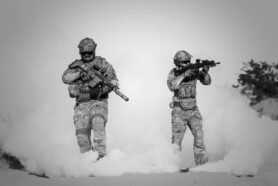Inter arma enim silent leges, proclaimed Cicero; in times of war, the law falls silent. This ancient adage has long resonated as a concise explanation of the relationship between law and war. Law, connoting stability, order and peace, is commonly regarded as antithetical to war, a lawless state of violent disarray. In an era of surgical precision and sanitised violence, this idea is worth revisiting.
Craig Jones deftly challenges this simplistic understanding of law in war (or rather, its absence) in Lawfare and the Juridication of Late Modern War. He contends the concept of ‘lawfare’ reveals that “war, violence and law are not separate or oppositional spheres, but rather animate one another in all kinds of ways.” He is correct to note this is not a profoundly new phenomenon, however the significant traction it has gained in the post-9/11 era is deserving of closer study.
Originally coined by Colonel Charles Dunlap in 2001, the portmanteau of law and warfare was shorthand for the instrumental use of law as a weapon of war. Dunlap was inspired by what Richard Betts described as the “hyperlegalism” of US-led NATO bombings in Kosovo and Serbia in 1999, where legal experts played an unprecedented role in managing combat operations. This development, Dunlap argued, enabled the transformation of law into a discursive tool in the arsenal of the ‘Other’, one which could be used “to exploit American values in ways that actually increase risks to civilians.” Dunlap was referring here to the various legal challenges mounted against the United States for its operations in Afghanistan, Iraq and Guantanamo Bay, which allegedly generated a “mistreatment narrative.” This early, narrow conceptualisation of lawfare as a discursive tactic deployed exclusively by the enemy ‘Other’ is intriguing but incomplete.
Jones thickens this analysis considerably. By drawing upon Critical Legal Geography, Critical Legal Studies, and Third World Approaches to International Law, he skillfully contextualises lawfare both spatially and historically. Recognising the age-old relationship between law and violence is characterised by its corporeal effects allows him to produce a much fuller analysis. The result is a broadened conceptualisation of lawfare as not just a discursive construction but a performative act with distinct effects on the battlefield. Perhaps most importantly, Jones moves beyond static interpretations of lawfare to ask not only what lawfare is, but what it does.
What does this mean for remote warfare? Jones helpfully elaborates in Travelling Law: Targeted Killing, Lawfare and the Deconstruction of the Battlefield. This book chapter considers the instrumental use of law to ‘legalise’ assassination and ‘deconstruct’ battlefields. Remote warfare, characterised by a physical and metaphorical distance between combatants, is highly relevant to lawfare in this regard.
It has been observed elsewhere that drones are not a policy for hunting terrorism, but a tool. The policy is assassination. Jones uses the concept of “travelling law” to detail how the legal model for this assassination policy was first developed by Israel before being adopted and expanded by the United States. The legal justification and consequent normalisation of targeted killing in this manner is an act of lawfare not dissimilar to the ‘weaponisation’ of law Dunlap feared enemies using against the United States.
By drawing heavily from Derek Gregory’s concept of Everywhere War, Jones considers the use of law in eroding battlefield boundaries. When some interpretations blur contemporary battlefield boundaries to include “anywhere terrorist attacks are taking place, or perhaps even being planned and financed,” the resulting legal framework is so expansive it renders almost anything and everything legally permissible. Here lies the obsolescence of legal and geographical demarcation in remote warfare. This is an intensely problematic situation, Jones warns, as the ever-expanding reach of modern warfare narrows the space left to escape, evade or stop violence.
Taken collectively, the instrumental use of law to normalise assassination and deconstruct the battlefield paint a grim picture of geographically and legally unconstrained remote warfare. “Far from falling silent,” Jones rebukes Cicero, “law constantly intervenes in and gives shape to war.” This is especially pertinent to remote warfare. While distance obscures and clouds the precise nature of warfare in the 21st century, lawfare may help render it visible.
Sources:



